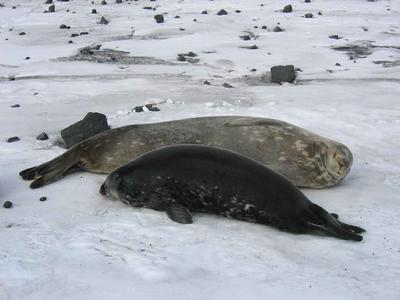21 November, 2003
Today was a great day to be a seal-and a seal counter. The past
week's low pressure system with its endless grey skies and stiff
winds moved on just as we left camp this morning, leaving blue skies,
relatively calm winds, and warmish temperatures in its wake. We
recorded the largest number of seals for any of our four
censuses-1061 seals were out on the ice today. Out of those 1061
animals, we only had four pups that needed tagging. These rather
large pups were in a group of seals near South Base that had been
missed in previous censuses. While pupping has tapered off, there
seemed to be more seals just out on the ice, lounging around holes
that have opened up in some of the newer ice cracks. It's a good
thing that the seals are black, and lie against a white background.
It definitely makes them easier to spot when you're bouncing across
the sastrugi on your snowmobile.
An interesting statistic from today's count was the presence of a
female who was first tagged as a pup in 1973. In her 30 years, she
has given birth to 14 pups that have been tagged. Her first pup was
born (or at least the first pup that was tagged) in 1983. This
mother is older than most of the people on our seal research team.
The thing that struck me after looking at almost 150 adult seals and
pups today was the variability in pup size. While some are almost
full-grown mini-seals, others are still pups with long fur and a
definite uncoordinated look to their movements. The older pups are
attempting to imitate their mothers' vocalizations-making an
assortment of grunts and growls that are not quite puplike anymore,
but certainly wouldn't pass for an adult's calls.
The pup's weight gain is their mother's weight loss. The estimate is
that each kilogram of weight gained by the pup costs the mother 2
kilograms. To put it more simply, a pup that gains 50 kg has caused
its mother to lose approximately 100 kg. By the time some of the
pups are weaned, they may weigh 100 kg-that translates to a 200 kg
weight loss for the mother. If the mother started out around 400 kg,
she would be down to around 200 kg by that point in time. Producing
a supply of milk with a fat content of 50-65% for a period of 6 weeks
is energy-intensive for these mothers and represents a big investment
in the survival of their pups.
Wandering through the seal colonies gives plenty of time to think
about the questions that are raised by a long-term study such as
this. While the database represents 30+ years of tagging
information, many of the larger questions are still unanswered. The
logistics are incredibly complex for studying a population of seals
in an area with such extreme weather as Antarctica-following seals in
the winter dark and cold is difficult, to say the least. No one is
quite sure where the pups go after weaning-often they are not seen
again for at least 3 or 4 years. Another unanswered question is
whether there is any correlation between where the ice edge is each
year and the numbers of seals at each colony or the number of pups
born, as well as the number of pups that survive. Do some colonies
have a higher rate of success, measured by pup production and
survival, than others? If so, what factors play a part in this
success? I am constantly amazed at the fact that an animal
population that has been studied as intensively as this one still
provides us with so many mysteries and opportunities for future
studies.
Daily Haiku:
Black seals on the ice
Visible from far away
Is that just a rock?

This pup is almost as large as its mother and has already molted most of its long fur.

Here's a much smaller pup and its mother.

Can you see the group of seals in this photo? Look for the small black dots on the ice in the center of the photo. Sometimes it's pretty difficult to see the seals as you are driving by on your snowmobile and trying to divide your attention between route-finding and seal-spotting.
Contact the TEA in the field at
.
If you cannot connect through your browser, copy the
TEA's e-mail address in the "To:" line of
your favorite e-mail package.
|
